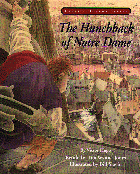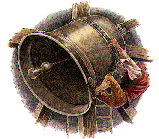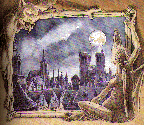


|
The Hunchback of Notre Dame.
Victor Hugo. Retold by Tim Wynne-Jones. Illustrated by Bill Slavin. Subject Heading:
Grades 4 and up / Ages 9 and up. *** /4
|

excerpt:
Through the streets the ragged parade bore the King of Fools until, at last, they reached the bonfire at the Place de Greve. The crowd parted and there danced Esmeralda the gypsy girl. A nymph, a goddess. Her streaming black hair jingled with brass coins. A beautiful white goat, its hooves and horns painted gold, pranced around her. Oh, how Quasimodo's heart clattered in his swollen chest to see her dance.
 Award-winning children's and young adult author Tim Wynne-Jones has retold Victor Hugo's classic The Hunchback of Notre Dame as a children's story book, and done an admirable job.
Hugo's weighty tome has enough layers of good and evil engaged in dramatic conflict to satisfy even the current Disney movie generation. (Which perhaps explains the Disney animated version, though it probably has more to do with marketing Quasimodo dolls.) Wynne-Jones employs a writerly style that sometimes gets bogged down in awkwardness - "Every street was a jumblement of cold and grasping shadows" - but the language strives to match the passion of the story, and I found myself carried along by the sheer drama and poignance of it all.
Award-winning children's and young adult author Tim Wynne-Jones has retold Victor Hugo's classic The Hunchback of Notre Dame as a children's story book, and done an admirable job.
Hugo's weighty tome has enough layers of good and evil engaged in dramatic conflict to satisfy even the current Disney movie generation. (Which perhaps explains the Disney animated version, though it probably has more to do with marketing Quasimodo dolls.) Wynne-Jones employs a writerly style that sometimes gets bogged down in awkwardness - "Every street was a jumblement of cold and grasping shadows" - but the language strives to match the passion of the story, and I found myself carried along by the sheer drama and poignance of it all.
 For those of you unfamiliar with the story, Quasimodo, a hunchback, is employed to ring the bells of Notre Dame cathedral. He is grotesquely disfigured, made deaf by the bells; a figure of derision who is destined to be unloved. He falls in love with the gypsy girl Esmeralda, who only has eyes for the dazzling captain of the guards, Phoebus de Chateaupers. Phoebus is killed by the evil archdeacon of Notre Dame, Dom Frollo, who desires Esmeralda for himself. Esmeralda is wrongly accused and convicted of Phoebus' murder and sentenced to hang. As she is being lead to the gallows, Quasimodo swoops down and carries her to the sanctuary of the church. The resolution is bittersweet. Esmeralda gains her freedom and is reunited with her mother, but Quasimodo is never to be loved, a fate so painful he proclaims "Would to God I were made of stone." The hero's victory is shadowed by his personal tragedy, and makes this story an appealing introduction to the genre for elementary readers. Who knows what reading interests it may spawn down the road? I know that I'm inspired to read the original (translated) for myself.
For those of you unfamiliar with the story, Quasimodo, a hunchback, is employed to ring the bells of Notre Dame cathedral. He is grotesquely disfigured, made deaf by the bells; a figure of derision who is destined to be unloved. He falls in love with the gypsy girl Esmeralda, who only has eyes for the dazzling captain of the guards, Phoebus de Chateaupers. Phoebus is killed by the evil archdeacon of Notre Dame, Dom Frollo, who desires Esmeralda for himself. Esmeralda is wrongly accused and convicted of Phoebus' murder and sentenced to hang. As she is being lead to the gallows, Quasimodo swoops down and carries her to the sanctuary of the church. The resolution is bittersweet. Esmeralda gains her freedom and is reunited with her mother, but Quasimodo is never to be loved, a fate so painful he proclaims "Would to God I were made of stone." The hero's victory is shadowed by his personal tragedy, and makes this story an appealing introduction to the genre for elementary readers. Who knows what reading interests it may spawn down the road? I know that I'm inspired to read the original (translated) for myself.
The vocabulary and metaphor-laden style will be difficult for young readers but is still worthwhile as they can draw meaning from context, from just the sort of story they love: a hero, a villain, a princess. (Well, Esmeralda could have been a princess.) Every student will understand the basic story; some will be able to access many levels of meaning. There are also many story interludes that lend themselves to review and prediction which also help teachers to expand student comprehension.
Bill Slavin's gothic illustrations, in muted colors, are packed with detail that children will enjoy. A dim light prevails throughout, creating an ambience that is just right for this sombre tale.
Recommended.
Leslie Millar is a mother and substitute teacher.

To comment on this title or this review, send mail to cm@umanitoba.ca.
Copyright © 1997 the Manitoba Library Association. Reproduction for personal use is permitted only if this copyright notice is maintained. Any other reproduction is prohibited without permission.
Published by
The Manitoba Library Association
ISSN 1201-9364
AUTHORS |
TITLES |
MEDIA REVIEWS |
BOOKSHELF
BACK ISSUES |
SEARCH |
HOME